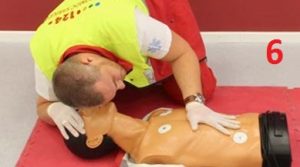BASIC APPROACH TO THE ACCIDENT
BASIC APPROACH TO THE ACCIDENT
In order to assess the patient's condition and determine what kind of help is needed, we approach the basic examination of the victim: 1. Safety 2. Checking the state of consciousness 3. We follow the CAB-D scheme C-circulation A-airway B-breathing breathing) D-defibrillation, use of AED (automatic external defibrillator)
The basic approach is universal for all casualties at the first aid level, and by properly applying the CAB-D scheme you will never make a mistake in the first aid process.
SECURITY
Before approaching an injured person and starting to provide First Aid, make sure the scene of the accident is SAFE.
Take care of -Personal safety -Safety of the injured -Safety of observer-environment
If the injured person or rescuer is in potential danger (eg spread of fire, possibility of explosion, collapse of the building, etc.), remove the injured person to a safe place in the safest way and then start providing First Aid.
If the scene of the accident is not safe for the rescuer, DO NOT APPROACH, inform the professional services (firefighters, police, emergency medical services) and leave it to them to solve the dangerous situation. \ N \ nDo not allow yourself to become a victim of the accident !!
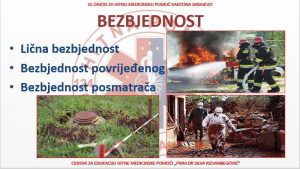

2. CONSCIOUSNESS TEST
Nakon što ste provjerili bezbjednost, prilazite unesrećenom i provjeravate stanje svijesti. Fiksirate glavu unesrećenog u zatečenom položaju stavljanjem dlana svoje ruke na čelo, sa ciljem da zaštitite i sebe i unesrećenog. Drugom rukom, lupkanjem po ramenu pokušavate ga dozvati. Ako unesrećeni reaguje i odgovori, znači da je svjestan, da ima pulsa i da diše (pogledati “Kratkotrajni gubitak svijesti”). Ako unserećeni ne reaguje, znači da je bez svijesti. Odmah zamolite da neko od prisutnih pozove HMP i donese AED-e.
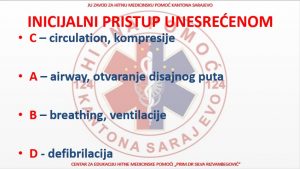
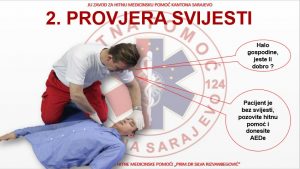
3. PULSE CHECK - C
If the casualty is unconscious, check for the presence of a pulse on the patient's neck. Place two to three fingers of your free hand on the indentation on the left or right side of Adam's apple and press lightly to feel the pulsations. The pulse check should not take longer than 10 seconds and never check the pulsations on both sides at the same time. If you feel pulsations in your neck, it is a sign that the victim's heart is beating, so check your breathing. If there is no pulsation, the victim's heart does not beat (see "Adult resuscitation")
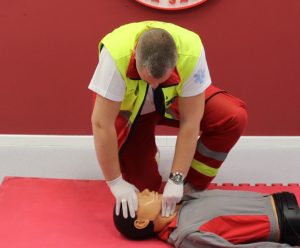
4. AIRWAY - A
Disajni put (usta, nos, ždrijelo, dušnik, bronhi i bronhiole) ima za ulogu da zrak iz atmosfere koji je bogat kiseonikom, prilikom udisaja ovlaži, očisti, zagrije i dovede do pluća gdje će se izvršiti razmjena gasova ( O2-CO2) , a prilikom izdisaja preuzeti CO2 izbaci u atmosferu. Ako disajni put nije otvoren i prohodan razmjena gasova neće biti moguća pa će zbog nedostatka kiseonika, za kratko vrijeme i srce da prestane sa radom.\n\n*NE MOŽETE provjeravati da li unesrećeni diše niti započeti vještačko disanje ako prije toga niste :\n\n1. PROVJERILI DISAJNI PUT\n2. OČISTILI DISAJNI PUT\n3. OTVORILI DISAJNI PUT
PROVJERA DISAJNOG PUTA (usta i nos)
*Ako je unesrećeni svjestan i razgovara sa vama, njegov disajni put je prohodan i nema potrebe za provjerom. Ako je unesrećeni bez svijesti i ne reaguje, prohodnost disajnog puta se mora provjeriti.\n\n*Jednom rukom na čelu i dalje fiksirate glavu unesrećenog u zatečenom položaju dok drugom rukom nježno otvrate usta i provjeravate ima li kakvog sadržaja. Ako je unserećeni u grču, nema nasilnog otvaranja usta. Dok čekate da grč prođe da bi otvorili usta, sadržaj koji se nalazi sa vanjske strane usta i nosa očistite maramicom kako bi unesrećeni lakše disao.
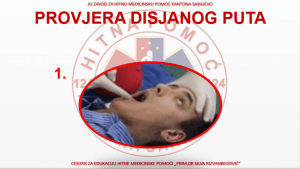
AIRWAY CLEANING
Once you have opened your mouth and noticed the contents (pieces of food, chewing gum, liquid or some foreign contents), they need to be removed to make the airway passable. Remove the solid contents with two fingers as tweezers or one finger as a hook, while for the liquid contents wrap a gauze or handkerchief around the finger and clean it. If you open the airway before checking and cleaning, you run the risk of the contents or foreign body in the mouth going into the lower parts of the airway and obstructing it. This will prevent independent or artificial respiration and thus prevent the flow of oxygen to the victim's lungs.
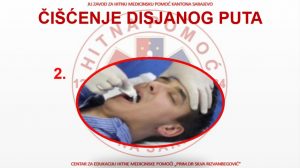
OPENING THE AIRWAY
After checking and cleaning, we proceed to open the airway. Unconscious people have no control over their muscles, so it can happen that the root of the tongue closes the lower parts of the airway and thus causes the cessation of breathing and then the cessation of heart function, especially if the victim is lying on his back. There is no need to "pull or remove" the tongue, because that way you can additionally injure the victim, but also expose the rescuer to danger. You continue to fix the victim's head with your hand on your forehead, while you place your other hand on the victim's chin or under the victim's neck and throw the victim's head backwards (Figures 3 and 4). As long as the victim's head is in the reclined position, the airway is open and the root of the tongue is pulled into the natural position. If the casualty is suspected of injuring the cervical spine, the head must not be moved. In this case, you open the airway by moving the lower jaw up and forward at the same time (Figure 5).
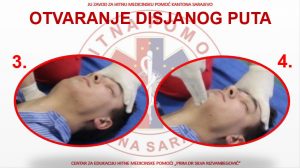
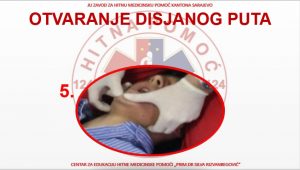
BREATHING - B
If the victim has no pulse, you will not waste time checking your breathing because without a pulse there is no breathing. If the victim has a pulse, after checking, cleaning and opening the airway, it is necessary to check breathing. You check your breathing with the "WATCH, LISTEN, FEEL" method. You watch for the chest to move, listen for air to flow from the victim's mouth and nose, and feel with your hand if the chest moves (Figure 6) While checking for breathing, your head must be in a reclined position. The breath test should not last longer than 10 seconds. If the victim has a pulse and is not breathing, start artificial respiration immediately.
